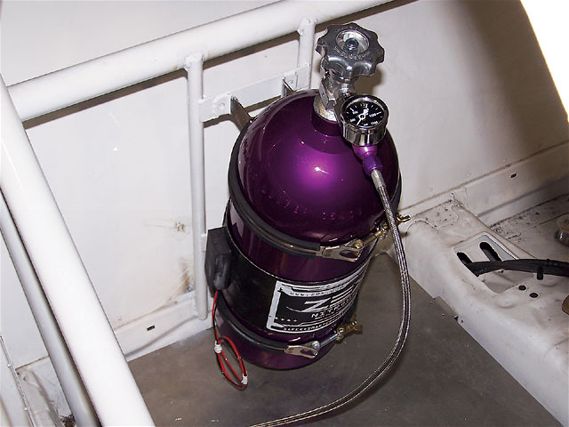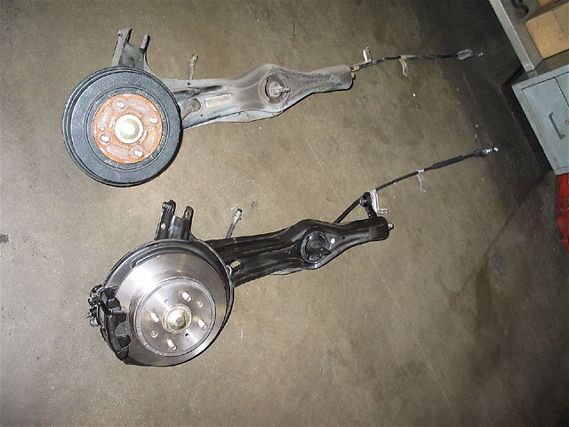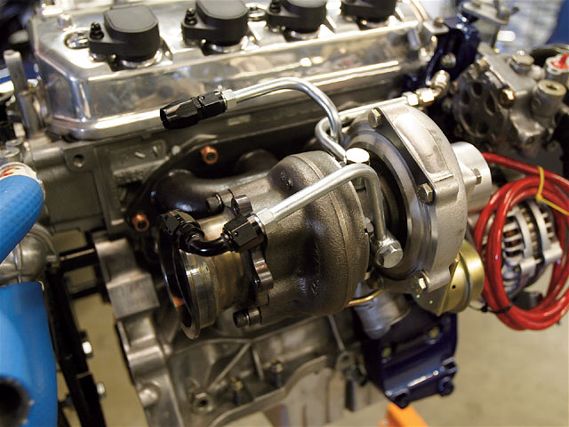 | Auto Repair and Maintenance - Exhaust Notes
| Auto Repair and Maintenance - Exhaust Notes
Time To Step It Up
I always get different opinions on this matter, so I wanted to ask the Honda experts themselves... What is the most affordable way to get a noticeable horsepower gain on my '94 Civic EX after a solid clutch, intake, header, and exhaust?
Leroy Diaz
Philadelphia, PA
Nitrous. Put the car on the bottle, step on the gas, squeeze that button, and fly. I'm going to assume from the nature of your question and the pre-existing modifications that you're relatively new to the scene. It is for that reason that I am telling you to get a nitrous bottle. You've gone in the right direction so far. There is definitely an order by which parts should be purchased and installed on a new enthusiast's ride. Intake, header, and exhaust will almost always come first. Wheels, tires, and suspension should usually follow. Once these parts have been addressed, it is time for a power adder. You could boost your car, but a turbo kit (especially a home brewed setup) is a major commitment, both monetarily and in terms of time, and could be a bit too much for a part-time enthusiast.
There are a few huge selling points for nitrous. First, you'll make about as much power with a nitrous kit as you would with a turbo kit on a stock motor. In both cases, you're limited by the bottom end internals, not the power adder itself. Second, it costs less than half as much as even the cheapest turbo setup. Third, and most importantly, you don't have to use the power adder all the time, which saves money on fuel and will help your motor stay reliable.
Every new car enthusiast should buy a nitrous kit at some point. Even if, 5 years from now, you've got a 700 wheel hp K-unit in your ride, you'll still have a bottle laying around to drop in a rental car if you're bored (like we did, July '06). - Dr Barrios
Chicks Dig Long Rods
I've always wanted to do a big bore N/A B-series with a B16A crank-big, like an 87mm bore with compression around 12:1. It seems to me that an engine built like this could make max power at very high rpm, maybe near 10,000. With the 77.4mm stroke, and the high rod-to-stroke ratio that comes with it, the engine will survive revs like this. I'm sure it would not make gobs of torque, but I like revs. Am I crazy? What is wrong with this idea? Would low-end power suffer badly?
I have engaged in many arguments with gear heads about why Honda even bothered to make the B16A. "What's the point in making a 1.6L B-series?" they say. "They should have all been 1.8s or 2-liters..." Of course I defend Honda to the death, not only because I own a B16A but also because I have a good feeling why they made this specific engine configuration. I tell them, "You don't know what a rod/stroke ratio is, do you?" Most say no and get flustered, but a few say "yes" and know what I'm getting at: ring wear, or lack of it. I think Honda made the B16 because they knew people would want to rev the hell out of their 8200rpm redline motor. Period.
Bryan McDonough
Bowdoinham, ME
I would venture a guess that the reason the B16 is designed that way is for emissions purposes. A motor that makes all of its power on top and has a separate low-speed cam profile will have super-low emissions numbers (every test involved is done under 5000 rpm) and still be a force to be reckoned with. If the B16 wasn't enough for you, there was always the option of stepping up into an Integra with a 1.8L, and subsequently into the next class (which includes higher initial costs and slightly less gas mileage).
As far as your dream motor is concerned, there are a few things you might want to think about before diving in. First, an 87mm bore is unstable. Even though the high R/S ratio will help take away some of the lateral stress on the sleeves, the paper thin walls of an 87mm bore will not last very long. It is most common to go with an 84mm bore if you're worried about longevity.
Every step up thereafter is going to take away some reliability. An 84mm bore will put you somewhere near a 1700cc displacement; an 85 will get you about 50cc on top of that. Second, you're not going to get a whole lot of displacement from the overbore. You might want to consider using a 1.7L crank if you're planning on street driving this motor. The 1.7L crank will net you an extra 100cc's over the B16 and still keep you in roughly a 1.6:1+ rod-to-stroke ratio-sounds like the best of both worlds to me.
That said, I think this motor would be fun as hell. Build it. Don't worry about what everybody else says. I like high-power/rev, low-torque motors, too. If anybody talks smack, just ask what he thinks about a stock F20C. That'll shut them up. - DB
 | Auto Repair and Maintenance - Exhaust Notes
| Auto Repair and Maintenance - Exhaust Notes
Yes, Master
I have a '94 Civic EX coupe and did the rear drum-to-disc brake upgrade myself. Is it necessary to go with a better brake master cylinder from a del Sol or GSR, or can I stick with the factory master cylinder?
Ray Montanez
Orlando, FL
Your car comes stock with a 7/8-inch piston in the master cylinder. There are two steps up from here. You can go with a GSR cylinder with a 15/16-inch bore, or a Type R unit rockin' a huge 1-inch slug. It isn't absolutely necessary, but you'll notice a huge difference in pedal feel and your ability to modulate the pedal pressure with the larger units.
If you're asking this because your brakes don't feel right after the swap, it is likely your proportioning valve is what's giving you trouble. You'll want to get a 40/40 prop valve from an Si or an Integra to sort out your front-to-back bias. Honestly, I wouldn't fret about the master cylinder until you decide to upgrade the front brakes. I personally rocked a 7/8-inch master on my EJ until I went to the 2-piston Legend calipers. Only then did I really feel like the 1-inch was necessary. - DB
Speak Softly, But Carry A Single Stick
Did you guys ever list the power numbers after "Bubba" tuned the D16 with individual throttle bodies, built head, and Arias pistons? I'm putting together a similar setup including homemade ITB's (mine are from a CBR 600), CroMe tuning software and some other bolt-ons. I'm curious because my motor has about 170,000 miles on it and is starting to burn oil. I wanted to put some pistons and rods in instead of just re-ringing it. I saw that you put the pistons on OEM rods and was wondering what kind of longevity you were expecting. I heard that OEM rods were one of the weak points in the motor.
I'm going to be using my car in quite a few SOLO events and possibly a weekend at the strip. Do you think I'd be OK with the OEM rods? I'm on a budget of about $650.00 and I haven't been able to locate a higher compression piston/rod combo in my price range. This car is also my daily driver so I want to be able to stick with 91-93 octane and not be worried about detonating. That's why I was gonna go with a 10.5:1 comp. ratio. Any suggestions/advice/info would be great. I was thinking about JDM ZC pistons and Scat rods, but I don't know what the compression ratio would be. Anyway, thanks for your time. LOVE THE MAG!
Steve DeMarco
Miami, FL
Unfortunately, that motor died before we could get it to the dyno. During its break-in period there was a pretty violent sand storm on the freeway, violent enough that grains of sand found their way into the intake tract and chewed up some valves. The guy who currently owns that bottom end should be getting it together soon, though, so there's still hope.
That motor was not too different from the ZC piston budget D-series we did later that year, which was inching on 150 wheel hp with a stock header, stock cam, and no ITB's. I expected to see somewhere near 175 wheel hp out of the first motor. I'll build another someday.
A far as your motor goes, you're right to be concerned about the rods, sort of. Stock rods are the second weakest link for a turbo car. First the ring lands will go, then the rods. Luckily, you don't have a turbo car, and there hasn't been an N/A D-series powerful enough to break the stock rods that I've ever seen. Power and internal stress are directly proportional, and I've personally made 215 wheel hp on a stock Z6 bottom end via boost. As long as you're making less power than that, you'll be cool with the stock rods.
If you've got a tight budget, I'd probably spend the cash on some ZC pistons and rods, a good cam, intake manifold, and a header. These parts combined will make a fun motor that's cheap enough to beat on all day and not be worried. - DB
Allergic To White Rice
I live in Helena, Mont., where there is absolutely no import scene whatsoever. I am the proud owner of a '97 Accord SE coupe, and I have replaced quite a few parts with JDM ones. I get crap from people driving Cavaliers with fart-can exhausts and "Fast and Furious" graphics for driving an import, a Honda at that. The ONLY thing keeping me from going completely insane is my love off all things with an H on the hood, and your magazine. Keep up the excellent work.
Zach Demaray
Helena, MT
Word. Cavalier guys suck. There isn't a single thing that can justify buying a Pontiac Sunfire over a Honda Civic. I applaud you for sticking to your guns and rolling how you want to roll. If we paid attention to every domestic douche-bag Honda hater, this would be Mustang Tuning magazine and I'd have a mullet. - DB
If Only They Had C16 at the Pump
I am currently doing an LS/VTEC conversion. Right now I have a B18A block and P72 GSR head with Brian Crower 4 cams, springs, and retainers, and flat- face Supertech valves. I plan on using Civic Type R pistons. My question is what will my compression ratio be? Would it be a good daily driver on pump gas, and what spark plugs would one use with this set up?
Dev Saklkey
Skokie, IL
Whoa, I think you're getting ahead of yourself. That setup would put you in the mid-14:1 compression ratio range. Add twenty points to your pump gas' octane rating and you could probably pull that setup off. Even with JDM Type R pistons, you'll be looking at a high 12:1 ratio. The dynamic compression from your humongous cams should probably make the P73's work on pump gas, but it'll be right on the brink of needing to step up to race gas. To answer your second question, use 9's; they'll work great. - DB
 | Auto Repair and Maintenance - Exhaust Notes
| Auto Repair and Maintenance - Exhaust Notes
John Rodriguez' First Fan
Please help! I'm in the Army and during my deployment Honda Tuning and Sports Compact Car are all I read. I have a '03 Civic EX. The car comes with the D17, the bastard child of Honda engines. There are so few parts out there for the car and motor. I know a lot of people are doing the K-motor swaps, but I want to do something different. I thought I was saved in the April or May '06 issue, when you were about to do a series to show the power the D17 could put out. You did the fuel pump but you never continued the build. Maybe you can help me.
I bought a built turbo block that can withstand 24psi and lowers the compression from 10:1 to 8:1, and I want to get a stronger head. The thing is, there are not many quality turbo kits for the D17 and I don't know what is the best ECU or piggyback system to go with. Once again, there are not many options out there for this application. Please help!
Brian Henriksen
Ft. Capmbell, KY
Our buddy John Rodriguez has been building his setup for some time now. It is actually sitting at the dyno shop waiting to be tuned as I write this. There will be a final installment of the story whenever he can get the thing finished.
If you've got a block that can handle that much boost, you probably shouldn't be too worried about the head. Boost isn't going to break anything in the top end; 90 percent of the turbo motors I see are built bottom end-with-stock top end combinations. The thing you should be most concerned with is the fuel and fuel management. If you run a return system, like John did, you'll be one step closer to an easily tunable ride.
Being able to control fuel pressure with an adjustable FPR is key; even guys with K-swaps usually do this. John is using a GReddy e-Manage for his kit. While the e-Manage is a decent piggyback controller, you'll probably want to go with a standalone unit if you can swing the cost. Look to the AEM EMS for your best bet. There's also a possibility you might get a Hondata K-Pro to work.
When you choose to do a project like yours, one that hasn't already been done thousands of times, you are also choosing into doing the legwork and figuring things out on your own. A whole lot of what you're doing will have to be custom. Good luck; be ready for tons of hard work and sleepless nights trying to get a project like this together. I'll tell you this much: the knowledge learned and satisfaction of completing the job is definitely worth every bit of stress that it'll take to make it happen.
Got Questions, Comments, Love or Hate? Send your letters to:
editorial@hondatuningmagazine.com
Snail mail: 2400 E. Katella Ave, Ste. 1100, Anaheim, CA 92806
